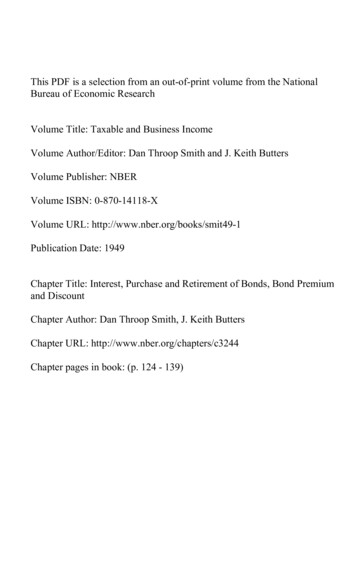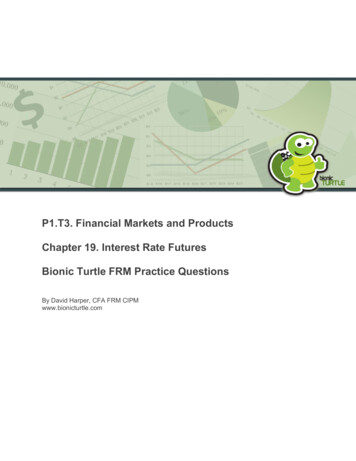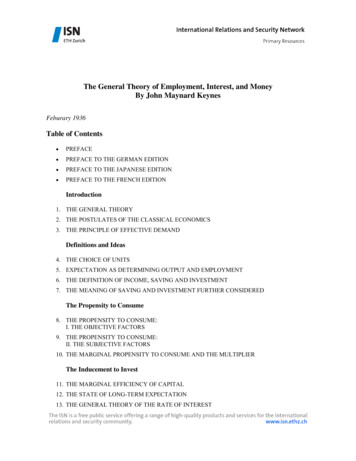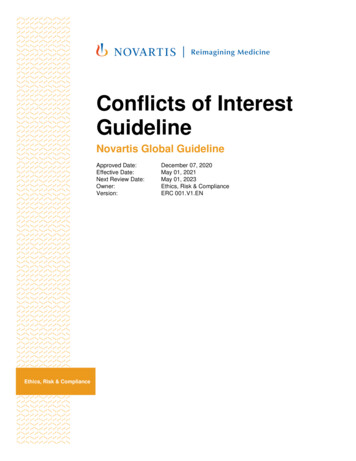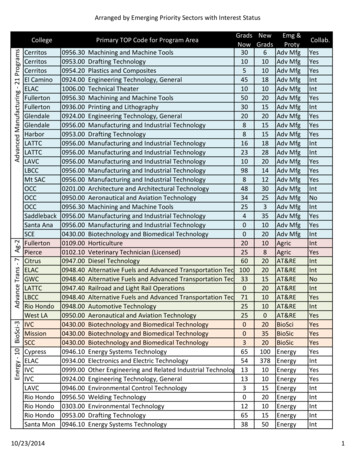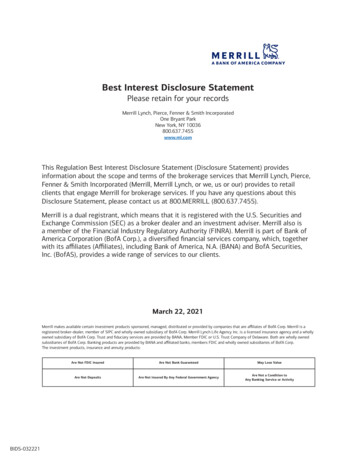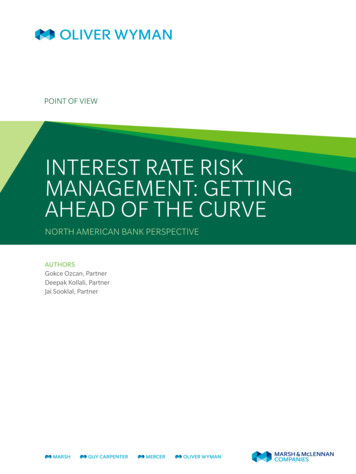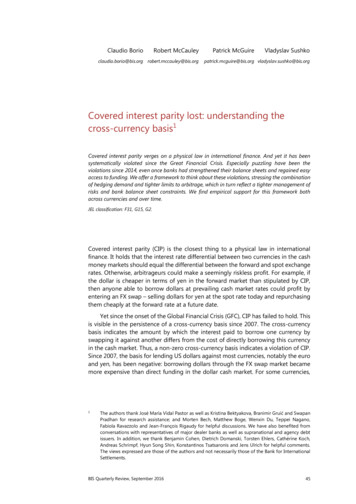
Transcription
Claudio BorioRobert McCauleyclaudio.borio@bis.org robert.mccauley@bis.orgPatrick McGuireVladyslav Sushkopatrick.mcguire@bis.org vladyslav.sushko@bis.orgCovered interest parity lost: understanding thecross-currency basis1Covered interest parity verges on a physical law in international finance. And yet it has beensystematically violated since the Great Financial Crisis. Especially puzzling have been theviolations since 2014, even once banks had strengthened their balance sheets and regained easyaccess to funding. We offer a framework to think about these violations, stressing the combinationof hedging demand and tighter limits to arbitrage, which in turn reflect a tighter management ofrisks and bank balance sheet constraints. We find empirical support for this framework bothacross currencies and over time.JEL classification: F31, G15, G2.Covered interest parity (CIP) is the closest thing to a physical law in internationalfinance. It holds that the interest rate differential between two currencies in the cashmoney markets should equal the differential between the forward and spot exchangerates. Otherwise, arbitrageurs could make a seemingly riskless profit. For example, ifthe dollar is cheaper in terms of yen in the forward market than stipulated by CIP,then anyone able to borrow dollars at prevailing cash market rates could profit byentering an FX swap – selling dollars for yen at the spot rate today and repurchasingthem cheaply at the forward rate at a future date.Yet since the onset of the Global Financial Crisis (GFC), CIP has failed to hold. Thisis visible in the persistence of a cross-currency basis since 2007. The cross-currencybasis indicates the amount by which the interest paid to borrow one currency byswapping it against another differs from the cost of directly borrowing this currencyin the cash market. Thus, a non-zero cross-currency basis indicates a violation of CIP.Since 2007, the basis for lending US dollars against most currencies, notably the euroand yen, has been negative: borrowing dollars through the FX swap market becamemore expensive than direct funding in the dollar cash market. For some currencies,1The authors thank José María Vidal Pastor as well as Kristina Bektyakova, Branimir Gruić and SwapanPradhan for research assistance; and Morten Bech, Matthew Boge, Wenxin Du, Teppei Nagano,Fabiola Ravazzolo and Jean-François Rigaudy for helpful discussions. We have also benefited fromconversations with representatives of major dealer banks as well as supranational and agency debtissuers. In addition, we thank Benjamin Cohen, Dietrich Domanski, Torsten Ehlers, Cathérine Koch,Andreas Schrimpf, Hyun Song Shin, Konstantinos Tsatsaronis and Jens Ulrich for helpful comments.The views expressed are those of the authors and not necessarily those of the Bank for InternationalSettlements.BIS Quarterly Review, September 201645
Cross-currency basis against the US dollar, interbank credit risk and market risk1Three-month basisThree-year basisLibor-OIS spreads and the VIXBasis pointsBasis 0–1–21006081012USD/AUD14Graph 116USD/EUR060810USD/JPY121416Percentage points06081012Libor-OIS spread (lhs):USEAPercentage points01416Rhs:2VIXThe vertical lines indicate 15 September 2008 (Lehman Brothers file for Chapter 11 bankruptcy protection) and 26 October 2011 (euro areaauthorities agree on debt relief for Greece, leveraging of the European Financial Stability Facility and the recapitalisation of banks). 2 ChicagoBoard Options Exchange S&P 500 implied volatility index; standard deviation, in percentage points per annum.1Sources: Bloomberg; authors’ calculations.such as the Australian dollar, it has been positive (Graph 1, left-hand and centrepanels).Initially, the violations of CIP were seen as a reflection of strains in globalinterbank markets. Specifically, heightened concerns about counterparty risk andconstrained bank access to wholesale dollar funding inhibited arbitrage during theGFC, and again during the subsequent euro area sovereign debt crisis. But, puzzlingly,the violations have persisted even after these strains dissipated. The basis haswidened since 2014, for both short- and long-term borrowing, despite fadingconcerns about bank credit quality and recovery in wholesale dollar fundingmarkets.2 Why has arbitrage not reduced the basis to zero?In this special feature, we argue that the answer to this puzzle lies in thecombination of the evolving demand for FX hedges and new constraints on arbitrageactivity. The former explains why the basis opens up, and the latter why it does notclose. A growing demand for dollar hedges on the part of banks, institutionalinvestors and issuers of non-US dollar bonds has put pressure on the basis. At thesame time, limits to arbitrage (in the sense discussed by Shleifer and Vishny (1997),among others) have become more binding. These reflect lower balance sheet capacitybecause of tighter management of the risks involved and the associated balancesheet constraints. Empirically, we find that proxies for the volume of hedging demand,together with proxies for balance sheet costs, help explain CIP violations, both acrosscurrencies and over time. If the factors we identify are the right ones, CIP deviationslook to be here to stay even in non-crisis times, as long as the demand for currencyhedges is sufficiently high and imbalanced across currencies.32Also, unlike in earlier US dollar funding stress episodes (Cetorelli and Goldberg (2011, 2012)), bankshave drawn very little on central bank swap lines: aps-search-result-page.3Sushko et al (2016) treat these issues from a more technical perspective and provide broadereconometric results.46BIS Quarterly Review, September 2016
The rest of this feature is organised as follows. The first section lays out theframework for our analysis. The second and third sections examine, respectively, thevariation of the basis across currencies and over time in the yen/dollar basis. Theconclusion highlights some implications and outstanding questions.A frameworkThe basic mechanics behind CIP are fairly simple. Interest rates in the cash marketand the spot exchange rate can be taken as given – these markets are much largerthan those for FX derivatives. Hence, it is primarily shifts in the demand for FX swapsor currency swaps that drive forward exchange rates away from CIP and result in anon-zero basis (Box A). Any such deviations should, in principle, immediately triggerarbitrage transactions, bringing the basis back to zero. The reason is that, in an idealworld, CIP arbitrage is treated as riskless. By construction, FX swaps do not entail anopen currency position. In addition, it is assumed that the credit, counterparty, marketand liquidity risks involved are negligible. Unimpaired access to cash and derivativesmarkets then allows arbitrageurs to close the basis.In recent years, the textbook CIP arbitrage framework has been challenged intwo ways. Initially, the focus was on the constraints on arbitrage arising from thebanks’ counterparty credit risk concerns and the wholesale US dollar funding strainsthat surfaced during crisis episodes. These episodes included the Japanese bankingcrisis (the “Japan premium”, Hanajiri (1999)); the onset of the GFC in 2007–08 (eg Babaet al (2008), Baba and Packer (2009), Coffey et al (2009), Mancini-Griffoli and Ranaldo(2012), Levich (2012)); and the euro area sovereign debt crisis in 2011–12 (McCauleyand McGuire (2014), Ivashina et al (2015)).Since 2014, attention has shifted to other factors and constraints. Most studieshave invoked some notion of capital constraints of CIP arbitrageurs in the face of FXswap funding demand from banks (Iida et al (2016)), from foreign currency bondissuers (Liao (2016)) or from broader saving and investment imbalances (Du et al(2016)).4 Similarly, Shin (2016) attributes the persistent deviations from the CIP to asystemic risk factor linked to the US dollar’s role as the global funding currency.5Drawing on our more technical work (Sushko et al (2016)), the framework wepropose in this study has two features. First, it focuses on one key source of pressureon the basis, namely net foreign currency hedging demand that is largely insensitiveto the size of the basis. Second, similarly to other studies, it also assumes the presenceof limits to arbitrage linked to the costs involved in deploying balance sheets, in turnreflecting tighter management of capital and funding risks. This can create a balancesheet constraint on CIP arbitrage that becomes more binding as the size of theaggregate FX hedging positions grows.Our framework gives rise to two hypotheses. First, in the cross section, the sizeand sign of the basis across currencies should be related to the net hedging position4He et al (2015) take the currency basis as given, to study the effects of FX swap market dislocationson the ability of non-US banks to supply US dollar loans when US monetary conditions tighten.5Transaction costs also appeared to play a temporary role for some currencies in the aftermath of theSwiss National Bank’s abandonment of the currency peg (Pinnington and Shamloo (2016)).BIS Quarterly Review, September 201647
Box ACIP, FX swaps, cross-currency swaps and the factors that move the basisCIP is a textbook no-arbitrage condition according to which interest rates on two otherwise identical assets in twodifferent currencies should be equal once the foreign currency risk is hedged: 1 1 where S is the spot exchange rate in units of US dollar per foreign currency, F is the corresponding forward exchangerate, r is the US dollar interest rate, and r* is the foreign currency interest rate. In practice, the relationship between Fand S is read off market transactions in FX instruments, notably FX swaps and cross-currency swaps.In an FX swap, one party borrows one currency from, and simultaneously lends another currency to, a secondparty (see also Baba et al (2008)). The borrowed amounts are exchanged at the spot rate, S, and then repaid at thepre-agreed forward rate, F, at maturity. The implicit rate of return in an FX swap is determined by the differencebetween F and S, and the contract is typically quoted in forward points (F – S). If the party lending a currency via FXswaps makes a higher or lower return than implied by the interest rate differential in the two currencies, then CIP failsto hold. Typically, the US dollar has tended to command a premium in FX swaps. In this case, rearranging the CIPequation yields the following relationship between (F – S), r and r*: 1 1 1A positive (“wide”) value of (F – S), above, indicates that a party lending US dollars sells the foreign currencyforward at a higher dollar price than warranted by the interest differential. Equivalently, a party borrowing US dollarsvia an FX swap – say, to hedge its US dollar asset – is effectively paying a higher interest rate on the swapped dollarsthan is paid in the cash market.A cross-currency swap is a longer-term instrument, typically above one year, in which the two parties alsosimultaneously borrow and lend an equivalent amount of funds in two different currencies. At maturity, the borrowedamounts are exchanged back at the initial spot rate, S, but during the life of the swap the counterparties alsoperiodically exchange interest payments. In a cross-currency basis swap, the reference rates are the respective Liborrates plus the basis, b. Again, if the forward points (F – S) are greater than warranted by CIP, then, assuming a oneperiod maturity, the basis, b, will effectively be the amount by which the interest rate on one of the legs has to beadjusted so that the parity with the pricing of FX swaps holds: 1 1 In the above example, the FX swap implied US dollar rate,(1 ), exceeds actual US dollar Libor, 1 , ifthe party borrowing US dollars in a cross-currency swap pays the basis, b, on top of US dollar Libor. Thus, failure ofCIP has implications for the relative cost of funding in the cash and swap markets. Whenever CIP fails, one party endsup paying the currency basis on top of the cash market rates to borrow the corresponding currency, while the othercounterparty in effect receives an equivalent discount when borrowing the other currency.A number of factors can cause CIP to fail. For example, market liquidity in the underlying instruments mayevaporate, so that the difference between bid and ask prices for forward and spot transactions is non-trivial. Forsimplicity, let us assume that r* is sufficiently small, so that 1 1. Denoting bythe spot ask rate and bytheforward bid rate, CIP deviations due to a drop in market liquidity will be given by: ( ) CIP can also fail because of credit risks in the underlying investments. If CIP arbitrage is conducted by global banksborrowing and lending in the respective Libor markets, then a rise in counterparty credit risks in the interbank markets,typically captured using Libor-OIS spreads, could result in CIP deviations. Similarly, if banks or asset managers engagein CIP arbitrage using government bonds in the two currencies, then deviations might result from differences insovereign credit risks, typically measured using sovereign CDS spreads.48BIS Quarterly Review, September 2016
More generally, suppose r and r* are the respective risk-free rates and rp is the risk premium for the underlyinginvestment over the duration of the swap. Then CIP deviations measured using risk-free rates will be given by: ( ) Even if risk premia in the underlying transaction are low, CIP deviations can arise if the demand to hedge one ofthe currencies is large. Then, even small risk premia can have big effects when scaled by the large size of the balancesheet exposures needed to meet the hedgers’ demand. For example, Sushko et al (2016) show that CIP deviation canbe proportional to the hedging demand multiplied by the per-dollar balance sheet costs of FX derivatives exposures: ( ) In each of the above examples, the price that is actually set in FX derivatives is that of the forward leg of theswap, F. As shown, CIP arbitrageurs will pass on their balance sheet costs of taking the other side of FX hedgingdemand via FX swaps as wider forward points, (F – S), than warranted by CIP. The per-dollar balance sheet coststhemselves are represented by rp in this example. Since markets have to clear, the aggregate position of CIParbitrageurs when the US dollar is at a premium in FX swaps will be equal to the aggregate net position of currencyhedgers. The latter will be paying the forward points, (F – S), to hedge their US dollar assets.What are some of the real-world counterparts to rp in non-crisis times? In aggregate, rp will reflect any costs thatbanks or other participants assign to deploying their balance sheet in CIP arbitrage, which in turn will reflect their riskmanagement practices. For individual players, these practices may even include absolute credit limits that would seta maximum for the underlying exposures to the underlying instruments and counterparties. Even without strict limits,the funding cost of the capital allocated to the arbitrage activity, notably to the (current and potential future)derivatives exposures involved, will prevent the basis from closing when it opens up owing to changes in hedgingdemand.The specific constraints, and hence the instruments involved, will also depend on the players acting asarbitrageurs. For instance, for highly rated supranational and quasi-government agencies, which can arbitrage thelong-term basis thanks to their top credit rating by issuing bonds in US dollars at attractive rates and then swappingthem out, rp is more closely related to the costs of placing bonds in different currencies. For hedge funds, which relyon collateralised markets to fund CIP arbitrage, the price and availability of repo market funding will play a significantrole.vis-à-vis the US dollar. Second, over time, the evolution of the basis should dependon that of net dollar hedging needs. Let us first consider each of the two componentsof the framework – FX hedging demand and constraints on arbitrage – in more detail.Demand for currency hedges: why the basis opens upHedging of open FX positions is the main proximate driver of the demand for FXswaps. We focus on three sources of hedging demand that are rather insensitive tothe size of the basis, and, hence, exert sustained pressure on it even when it is nonzero: demand from banks, institutional investors and non-financial firms.A first, structural source of demand for foreign currency hedges arises frombanks’ business models. For a long time, banks have been the main players runningcurrency mismatches on their balance sheets (managed mainly via swaps). Bankingsystems may be structurally short or long in specific currencies, given their coredeposit base. A shortfall in foreign currency funding can then be managed by cashborrowing in money and bond markets. The remaining gaps between banks’ assetsBIS Quarterly Review, September 201649
Box BReverse yankee issuance in the euro and the EUR/USD basisCorporate credit spreads in the euro bond market have fallen relative to those in the US dollar bond market, largelydriven by ECB bond purchase programmes (Graph B, left-hand and centre panels). In response, US firms have foundit more cost-effective to issue in euros, through so-called reverse yankee bonds, and then swap the proceeds into USdollars (right-hand panel). The hedging of currency risk by US firms issuing in the euro increases demand for crosscurrency swaps. Hence, the widening of corporate asset swap spread differentials and the surge in euro issuance since2014 have coincided with a marked widening of the currency basis (centre panel).For example, consider a BBB-rated US telecoms firm whose bonds yield 100 basis points over the interest rateswap rate in dollars, but only 50 basis points in euros. If CIP held, the firm would save 50 basis points by issuing ineuros and swapping back to dollars. In fact, the firm would have an incentive to do that for all its new debt. One canthen see the widening of the basis as tending to reconcile the different spreads in the two markets.According to data from Thompson Reuters, the majority of reverse yankee issuance has been long-term, with anaverage maturity of about 10 years and with 15- and 20-year tenors also commonplace. Issuance at shorter maturitiesis rare, because, from the perspective of the US non-financial issuer, the all-in issuance costs (ie taking the currencyswap into account) of short-term euro-denominated debt are still greater than issuing short-term US dollar debt,owing to the wider currency basis relative to the corporate asset swap spread differential at the short end.Corporate credit spreads, reverse yankee issuance and the EUR/USD basisCorporate asset swap spread06081012United States (US)Spread differential and the basisUS non-financial firms’ EUR debtissuanceBasis pointsBasis pointsUSD bn375150242507512125000–75Euro area (EA)060810121416Corp spread gap: 5-year currency basis:US minus EAEUR/USD1416–120608Sources: Bank of America Merrill Lynch; Bloomberg; BIS debt securities statistics; authors’ calculations.and liabilities in a given currency would be closed using currency derivatives such asFX swaps.6The second source of demand arises from the strategic hedging decisions ofinstitutional investors, such as insurance companies and pension funds. Institutional650Graph BFor example, in the second half of 2015, temporary pressure on non-US banks’ dollar fundingemerged as US money market funds (MMFs) divested from their unsecured obligations. This reflectedadjustment to US MMF regulatory reform set to take effect in October 2016. Still, at least inaggregate, non-US banks retained 5.5 trillion in deposits offshore and at their US branches in thelast three quarters of 2015, which rose to 5.7 trillion in Q1 2016, according to BIS and Federal Reserveflow of funds data.BIS Quarterly Review, September 201610121416
investors use swaps to strategically hedge foreign currency investments. In recentyears, the term and credit spread compression on the back of unconventionalmonetary policies in major jurisdictions has boosted these cross-currency investmentand funding flows.7 These investors’ hedge ratios tend to be quite insensitive tohedging costs and to move slowly over time.8 Thus, anything that induces theseinvestors to increase or reduce their foreign currency investments tends to putpressure on the basis.The third source of demand arises from non-financial firms’ debt issuance acrosscurrencies as they seek to borrow opportunistically in markets where credit spreadsare narrower. Under normal market conditions and for most currencies, this may notbe an important factor. But it can become quite relevant when credit spreads differsystematically, for example when they are compressed by central bank large-scaleasset purchases. Recently, for instance, many US firms needing dollars have beenissuing in euros to take advantage of very attractive spreads in that currency and havethen swapped the proceeds into dollars (Box B). This allows them to use the dollarsfor their business purposes while avoiding a currency mismatch in euros. Essentially,through the swap market, they borrow dollars and lend euros.Other factors could also put pressure on the basis, but we exclude them fromour analysis because of data limitations. Firms’ hedging of trade receivables orsubsidiary cash flows are one case in point. Another could be speculative FX positions,which can rely on forwards and swaps (eg yen carry trades). We posit, therefore, thatthe sources of pressure we identify are sufficient to capture the key relationships.9 Atthe more fundamental level, monetary (Box C) and financial conditions, as well asinstitutional differences across the respective jurisdictions, largely determine theextent of foreign currency funding and investment flows in the first place.Limits to arbitrage: why the basis does not closeStructural changes in how market participants have been pricing market, credit,counterparty and liquidity risks post-crisis have tightened limits to arbitrage. Balancesheet space is rented, not free.10 Specifically, as a result of tighter management ofrisks and related balance sheet constraints, arbitrage now incurs a cost per unit ofbalance sheet. This cost is passed on to the pricing of FX swaps, introducing apremium (or discount, depending on the currency) in response to imbalances in theswap market. One result is that the currency spot-forward relationship goes out ofline with CIP (Box A).7Domanski et al (2015) document increasing investment in long-term foreign currency bonds by theGerman insurance sector seeking to extend asset duration so as to match the rising duration of itsliabilities as yields in the euro area fell to very low levels.8The FX-hedged investment has a payoff that resembles the return of leveraged investors in the targetbond market: in the case of bonds, this is equal to the excess of the bond yield over the short-termfinancing cost (“the carry”), plus or minus a price gain or loss on the bond.9This would be so if the other sources of FX hedging demand co-move positively with those weidentify. The exclusion of speculative demand may actually make it harder for us to find a relationshipwith hedging demand, as speculation may lead to offsetting pressure on the basis. For instance, easymonetary policy could boost FX-hedged investments in search of higher returns, but it could alsoencourage carry trades. Those carry trades could push down the forward rate even as hedgingdemand pushed it up.10For a conceptual discussion, see Duffie (2016).BIS Quarterly Review, September 201651
Arbitrage can be both costly and risky. Typically, it requires the arbitrageur toenlarge its balance sheet, incur credit risk in both borrowing and investing, andpossibly face mark-to-market and liquidity risk (given the need to transfer collateralor take paper gains or losses) in the valuation of the positions.While these risks and costs exist all the time, participants have been managingthem more actively post-crisis. Before the GFC, these risks were not fully priced in therelevant markets and, partly as a result, dealer banks had raised their leverage todangerous levels (Shin (2010)). The crisis brought them to light. Since then, pressurefrom shareholders, creditors and prudential authorities has reinforced and hard-wiredparticipants’ awareness. As a result, leverage has declined and there has been lesswillingness to deploy the balance sheet for activities that make heavy demands on it,such as arbitraging the basis.Changes in regulation have reinforced market pressures for a tightermanagement of balance sheet risks. For example, changes related to credit valueadjustments have sought to incentivise dealers to price the counterparty risk in theirderivatives portfolios more accurately. Similarly, potential future exposure adjustmentcharges in both Basel III and US leverage ratios require market participants to holdcapital in proportion to their derivatives and other exposures.11The bottom line is clear. These tighter limits on arbitrage make it harder tonarrow the basis whenever it opens up as a result of pressures that reflect underlyingorder imbalances. In particular, even in the absence of bank funding strains like thoseseen during the GFC, a sufficiently high net demand for currency hedges could resultin persistent deviations from CIP.The currency basis in the cross sectionCan our framework help explain how the sign and, possibly, the size of the basis varyacross currencies? We test this by juxtaposing quantitative indicators for the variousplayers’ hedging demands and the basis.12 In evaluating the results, it should beborne in mind that the sample is necessarily limited, as we have to restrict it to freelytradable currencies in jurisdictions with no capital controls, with a highly ratedsovereign and for which data are available.Quantitative indicators of hedging demandAssembling estimates of hedging demand runs into two types of limitation.The first is conceptual. Some financial institutions play the dual role of puttingpressure on the basis and arbitraging it. For instance, banks’ business models maylead them to fund themselves through swaps in order to hedge their balance sheetmismatches, even as they act as arbitrageurs. This means that proxies for their swappositions conflate their two roles. However, and despite such ambiguity, our resultssuggest that the balance sheet hedging motive dominates.11This need not result from individual pricing decisions. For instance, internal credit limits may constrainindividual balance sheets and, in aggregate, be reflected in a larger basis.12Our findings also hold if price indicators are used; see Sushko et al (2016).52BIS Quarterly Review, September 2016
The second relates to data availability. No statistics fully cover the hedgingdemand for a given currency; tough choices and approximations are needed. Hence,we focus on the three main sets of players – banks, institutional investors and nonfinancial firms – and even there we have to make a number of assumptions.For banks, our benchmark measure is their “funding gap” in the US dollar.13 Thefunding gap, derived from the BIS international banking statistics, is an estimate ofbanks’ demand for hedging through the FX swap market (McGuire and von Peter(2009, 2012), Fender and McGuire (2010)). Specifically, for banks headquartered in aparticular country (eg Japan or Australia), we measure the difference between theirconsolidated global on-balance sheet assets and liabilities in a particular foreigncurrency. Assuming that banks hedge their currency risk, the resulting gap indicatesthe size of their off-balance sheet position in a given currency, which will largely bemanaged by FX swaps.14For institutional investors, we rely on central banks for estimates of Australian,euro area and Swedish institutions’ hedged foreign assets; and on industry sourcesfor Japanese life insurers’ holdings and hedge ratios.15 We neglect US investors’positions. This is not likely to be a problem, however, since US investors have moreopportunity to diversify without buying foreign currency assets, given the size of theglobal dollar financial markets.16For non-financial firms, we consider bonds outstanding issued by corporationsheadquartered outside the country, drawing on BIS international debt securitiesstatistics. For instance, we take euro issues by US firms to fund their dollar operations,and exclude issues by banks to avoid double-counting.17 We do not include dollarissuance by non-US firms because, given the predominance of the US dollar as aninvoicing currency, many such firms do not hedge dollar debt (eg Borio (2016)).18Graph 2 shows indicators of hedging demand from the various sectors for fourjurisdictions for which we were able to obtain better data: Australia, the euro area,Japan and Sweden. A positive value for a bar indicates net borrowing of US dollars13Except in the case of Sweden, where we also look at the euro (see below).14Partly owing to data limitations, we do not include US banks’ corresponding positions. USheadquartered banks’ estimated net long positons in the key currencies we are considering arerelatively small compared with non-US banks’ net long dollar positions. As a result, the bulk of ouranalysis can safely focus on the latter.15This means that, except for the euro area, we cannot single out US dollar holdings, so that ourestimate is an upper bound for the institutions covered.16Three quarters of US investors’ holdings of foreign bonds were dollar-denominated at the end of2014 (US Treasury et al (2016)). In general, hedge ratios for foreign equity holdings are low and wellbelow those for bonds, so that they
Covered interest parity lost: understanding the cross-currency basis1 Covered interest parity verges on a physical law in international finance. And yet it has been systematically violated since the


